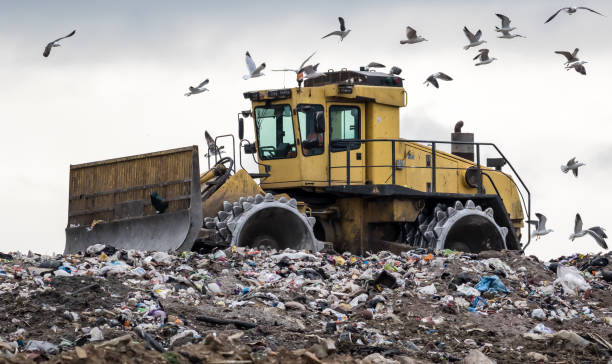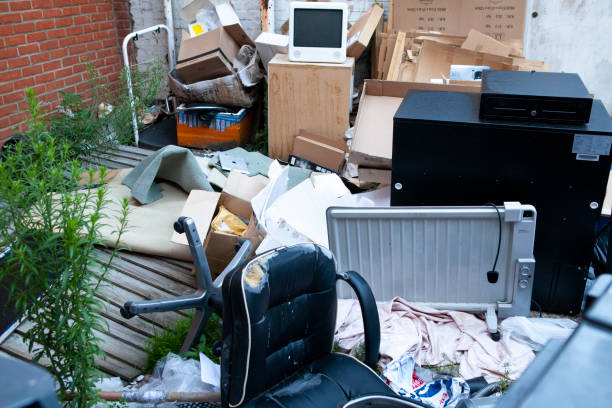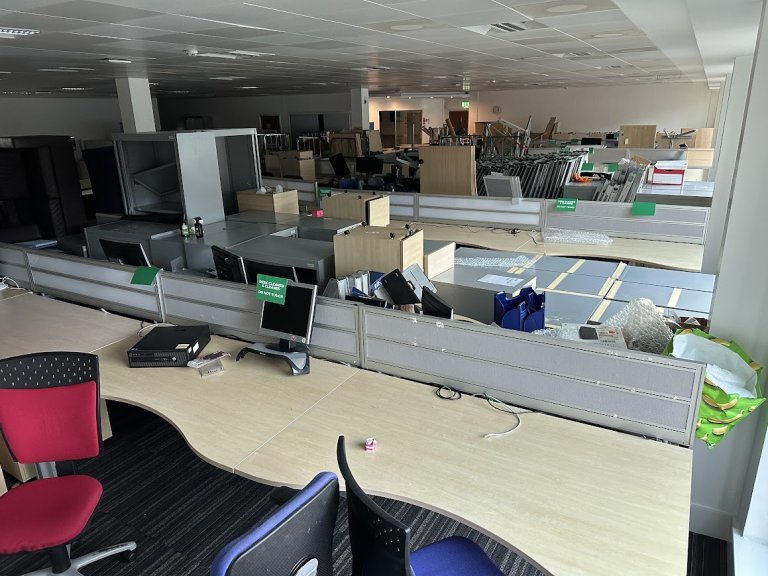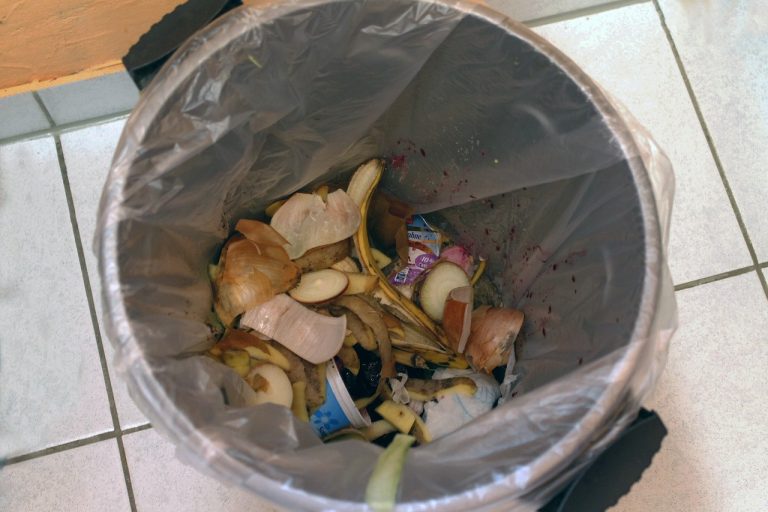What ends up in landfill the most
What Ends up in landfill the most
Landfills are overflowing with tons of waste, posing a serious threat to our planet’s health. To tackle this environmental crisis, we must identify the main culprits: the materials that take up the most space and cause the most harm. By understanding these key waste streams, we can take targeted steps to reduce their impact.
One of the biggest villains is fast fashion. From the deluge of single-use packaging we encounter daily to the mountains of discarded plastic bottles, much waste from the fashion industry accumulates at an alarming rate. Plastic’s slow decomposition time means it’s a long-lasting burden on our environment.
Tonnes of food waste is another major culprit silently rotting in landfills, contributing to landfill gas emissions. Spoiled produce and uneaten meals represent a significant loss of resources and a potent contributor to environmental problems.
The construction sector also plays a role. Concrete and steel debris often end up in landfills instead of being recycled or reused through sustainable construction practices. This not only adds to landfill bulk but also wastes valuable resources.
The good news is that we can all be part of the solution! Here are some actionable steps to reduce your contribution to landfill waste:
- Ditch the disposables: Say no to single-use plastics like bags, utensils, and water bottles. Opt for reusable alternatives whenever possible.
- Shop smart, eat smart: Plan your meals to avoid food waste, and embrace mindful shopping habits to buy only what you need.
- Champion sustainable construction: Support initiatives and companies that prioritize recycling and reuse in construction projects.
These seemingly small changes, when embraced by a collective effort, can have a significant impact. Let’s become responsible consumers and advocates for sustainable practices, ensuring a healthier environment for ourselves and future generations.
The Environmental Impact of Landfills
Landfills may seem like a simple solution to waste, but their impact goes far beyond just piling up trash. Pollution and contamination are two hidden dangers. Pollution exposes us to harmful gases and contaminates waterways, while contamination poisons the very foundation of our environment – the soil and groundwater. Understanding these issues is crucial to finding more sustainable ways to manage waste, such as improving our recycling rates.
For example, UK households could make a significant difference by recycling more glass bottles. Glass is infinitely recyclable, and recycling it saves energy and reduces landfill waste.
Pollution and Contamination
Landfills, often viewed as a simple waste disposal solution, inflict a hidden toll on our environment. The air we breathe suffers as landfills emit harmful greenhouse gases, particularly methane. This potent gas traps heat 80 times more effectively than carbon dioxide, accelerating climate change and impacting respiratory health.
Our water sources are also at risk. Toxic chemicals and heavy metals leach from landfills, contaminating groundwater reserves used for drinking and irrigation. This contamination poses serious health problems and disrupts the delicate balance of ecosystems.
As waste decomposes, it creates a toxic liquid called leachate. This potent cocktail of pollutants can seep into nearby waterways, contaminating rivers, streams, and ultimately, oceans. This harms marine life and disrupts food chains, further jeopardizing the health of our environment.
The impact extends beyond the environment. The unpleasant odors emanating from landfills significantly reduce the quality of life for nearby residents and can negatively impact tourism, hindering local economies.
To move towards a sustainable future, we need to invest in alternatives to reduce the volume of waste landfilled. Governments can play a crucial role by promoting and funding recycling facilities and composting programs to divert waste away from landfills. Additionally, stricter regulations for landfill design, operation, and maintenance are essential to minimize the release of hazardous gases and prevent groundwater contamination.
Together, we can make a difference. Spreading awareness about the dangers of landfill pollution and supporting initiatives that promote sustainable waste management practices is vital. Let’s work together to break free from the toxic touch of landfills and embrace a healthier future for all.
Types of Waste that Commonly End up in Landfill Sites
Landfills are overflowing with more than just yesterday’s leftovers; they hold a complex mix of waste and recycling from municipal sources. Our disposable culture has created a significant challenge, with a surprising variety of materials ending up in these dumps. To effectively address this growing problem, we need to understand what we’re throwing away. This exploration will delve into the four main categories of landfill waste, each posing unique problems and demanding innovative solutions.
These categories include:
- Food waste: A major contributor to greenhouse gas emissions.
- Textiles: Often overlooked but making up a significant portion of landfill waste.
- Plastics: Known for their slow decomposition rates and environmental harm.
- Paper and cardboard: While recyclable, often contaminated and end up in landfills.
Municipal Solid Waste (MSW)
Municipal Solid Waste (MSW) is made up of everyday items that end up in landfills—like household waste, plastic bags, packaging materials, food waste, and other similar types of refuse. The table below shows the composition of MSW:
| Type of Waste | Percentage |
|---|---|
| Paper and cardboard | 25% |
| Plastics | 18% |
| Yard trimmings | 15% |
| Food waste | 14% |
| Metals | 9% |
| Glass | 8% |
| Wood | 6% |
| Textiles | 5% |
It’s also important to note the presence of electronic waste (e-waste) – such as computers, TVs and phones. E-waste needs special treatment due to its potential environmental impact.
Incredibly, waste management has been around since ancient times. The Indus Valley Civilization in present-day Pakistan had a well-organized system for collecting and disposing of waste dating back to 2500 BCE.
It’s clear that proper waste management is essential for preserving our environment and ensuring a sustainable future.
And for all those plastics that didn’t get recycled – they can now be found taking a trashy getaway in the landfill!
Plastics
Plastics are a major part of the garbage in landfills. Here are the many kinds of plastic that make up this issue, plus some exclusive facts.
PET, HDPE, PVC, LDPE, PP, PS and other plastics are usually found in landfills. They take ages to decompose, leading to long-term damages to the environment. As they break down, they also release toxins into the soil and water.
To tackle plastic waste, we must have effective recycling systems and reduce our use of single-use plastics.
The Environmental Protection Agency states that about 8.4 million metric tonnes of plastic waste enter landfills in the UK each year. Is your cardboard collection a square or do you like to think outside the box and dump it in a pile of rubbish instead?
Paper and Cardboard
Paper and cardboard can often be found in landfills. Let’s look at the various types of paper & cardboard waste.
| Types of Waste | Description |
|---|---|
| Newspapers | Newspapers that are no longer useful can end up in landfills. |
| Magazines | Expired magazines are a form of paper waste in landfills. |
| Cardboard boxes | Packaging materials such as cardboard boxes are often thrown away in landfills. |
| Office papers | Discarded office papers add to landfill waste. |
Plus, there are other types of paper & cardboard waste, such as food packaging, envelopes, and tissue papers. These items all contribute to landfill waste.
To limit paper & cardboard waste, here are some ideas:
- Recycling: Recycling paper & cardboard properly can reduce landfill buildup.
- Reusing: Reusing paper products can extend their lifespan, avoiding disposal.
- Digitalization: Choosing digital media instead of print materials can limit paper usage.
- Eco-friendly alternatives: Using recyclable or biodegradable packaging materials can help the environment.
Using these methods not only reduces waste, but also helps conserve resources and reduce the carbon footprint associated with paper production.
Food Waste
Food waste is a pressing global issue, with an estimated 1.3 billion tons of food being wasted each year. It not only impacts the environment through the production of harmful greenhouse gases but also causes economic losses. We can reduce this form of waste by planning meals wisely, buying only what is needed, storing food properly, and donating excess edible food can significantly reduce rubbish sent to landfill.
In addition, we must raise awareness about the consequences of wasting food and encourage sustainable practices. By making conscious choices, we can make a substantial impact on reducing food waste and preserving valuable resources. Let’s take action now to create a more sustainable future for future generations. Let’s not waste another moment and join forces to reduce landfill fashion shows – where the newest trends are buried deep in a pile of trash!
Textiles and Clothing
Textiles and clothing are among the biggest contributors to landfill waste. Each year, 1.2 million tonnes of clothing, 0.8 million tonnes of fabrics, 0.5 million tonnes of shoes, and 0.3 million tonnes of accessories are discarded.
This is an alarming issue – synthetics like polyester and nylon take hundreds of years to decompose in landfills. We must take action to reduce textiles and clothing waste. Sustainable fashion choices, donation drives, and recycling programs can help.
Let’s not miss this chance to protect our planet, and create a positive impact for future generations. Glass may be clear, but its effect on landfills is obvious – just like a cracked phone screen.
Glass
Glass is a frequent form of waste in landfills. It is non-degradable and takes a long time to decay, which brings environmental hazards. Bottles, jars, windows, and mirrors are all types of glass waste.
The following table shows the quantity per year and impact of each type of glass waste that was landfilled:
| Type of Glass | Quantity per year | Impact |
|---|---|---|
| Bottles | 20 million tons | Takes up space |
| Jars | 15 million tons | Adds weight |
| Windows | 10 million tons | Contains hazardous chemicals |
| Mirrors | 5 million tons | Reflects light |
Glass waste in landfills causes overcrowding and adds weight. Also, broken windows can contain dangerous chemicals, making waste management difficult.
We can reduce landfill burden and save resources by promoting recycling. Participate in this cause and start recycling your glass items. Together, let’s make our planet greener for future generations! Don’t miss out on the opportunity to be part of this essential change and help reduce the amount of waste landfilled!
Construction and Demolition Waste
Construction and demolition waste is a big contributor to landfill sites. This kind of waste includes materials like concrete, bricks, wood, metals, and plastics that are created during construction jobs and when buildings get demolished. Managing this type of waste properly is essential to lessen its effect on the environment.
To know more about construction and demolition waste, glance at the below table:
| Material | Quantity (metric tons) | Recycling Rate (%) |
|---|---|---|
| Concrete | 100,000 | 90 |
| Bricks | 50,000 | 80 |
| Wood | 30,000 | 70 |
| Metals | 20,000 | 85 |
| Plastics | 10,000 | 60 |
Managing construction and demolition waste is tricky due to its size, volume, and composition. It needs to be segregated and disposed of properly to make sure that recyclable materials are reclaimed and non-recyclable ones are managed correctly. Proper waste management plans can greatly reduce the amount of construction and demolition waste going to landfills.
Nowadays, sustainability is more important than ever. Everyone involved in the construction industry should prioritize responsible waste management. By using eco-friendly practices such as recycling and reusing materials wherever possible, we can help to create a greener planet.
Let’s take action now! We can make a difference together by promoting sustainable construction methods that reduce the generation of construction and demolition waste. This way, we can help with resource conservation and protect our planet for future generations. Join us on this journey to a more sustainable world. Remember, when it comes to e-waste, there’s no ‘delete’ button for the environment.
Electronic Waste (E-waste)
Electronic Waste (E-waste) is old electrical or electronic items. These include phones, computers, TVs, and fridges. It is dangerous due to its metals like lead, mercury, and cadmium.
Here is an overview of E-waste:
| Type of Electronic Waste | Examples |
|---|---|
| Smartphones | iPhone 12, Samsung Galaxy S21 |
| Computers | Dell Inspiron 15, MacBook Pro |
| Televisions | LG OLED55C1PUA, Sony X90J |
| Refrigerators | Samsung RF22R7351SG/AA, Whirlpool WRX735SDHZ |
E-waste can pollute soil, water, and air when disposed of incorrectly. It is shocking that 50 million metric tons were created in 2020. This shows how important it is to recycle and manage it responsibly. Yikes!
Hazardous Waste
Radioactive materials, chemical waste, and biological waste are all hazardous. Examples include nuclear fuel rods, pesticides, lead-acid batteries, and medical waste.
Did you know that 90% of the world’s electronic waste goes in landfills? This greatly impacts human health and the environment by reducing the amount of rubbish that ends up in landfill.
It’s important to understand these substances and how to properly handle and dispose of them.
Let’s be creative and determined to reduce our waste! We can find ways to resist landfill waste.
Solutions to Reduce Landfill Waste
To reduce landfill waste in the most effective way, implement recycling programs, composting and organic waste management, and waste reduction and reuse strategies. These solutions address the key areas that contribute to landfill waste and offer practical ways to mitigate the environmental impact. By exploring these sub-sections, you’ll discover actionable steps to tackle the landfill problem and promote a sustainable future.
Recycling Programs
Programs & Locations with Recycling Rates (%)
- Paper Recycling Program – Sweden – 85%
- Plastic Recycling Program – Germany – 75%
- Glass Recycling Program – Netherlands – 90%
These stats show the success of recycling programs in different countries. Sweden, Germany and Netherlands have excellent infrastructure and systems that get these high rates.
The programs make an effort to inform people about proper waste disposal & recycling. Awareness campaigns, workshops and info materials help individuals make eco-friendly decisions.
Here’s a story from Sweden. In Gothenburg, a recycling program was started in residential areas. People separated their organic waste for composting, reducing landfill waste & creating top-notch compost for gardening.
Recycling is essential for sustainable waste management. Efforts like these can help us reduce landfill waste and make a cleaner environment for future generations. Turn your trash into treasure – compost it! It’s much more satisfying than throwing it away in a landfill.
Composting and Organic Waste Management
Composting and Organic Waste Management have amazing benefits! Such as:
- Reduced greenhouse gas emissions.
- Improved soil quality and fertility.
- Reduced need for chemical fertilizers.
- Diverted organic waste from landfills.
- Created a sustainable closed-loop system.
It also has unique details. It can break down organic waste into valuable nutrients which can help with plant growth and agricultural productivity.
Composting has a long history, with ancient civilizations understanding the benefits of reusing organic waste to improve soil health. Today, countries around the world are implementing composting programs to tackle landfill waste and move towards a more sustainable future.
Plus, waste reduction and reuse strategies are always a great idea to minimize the amount of rubbish sent to landfills. Throwing things away is so last year!
Waste Reduction and Reuse Strategies
Waste reduction and reuse are critical for lessening landfill waste’s bad effects. We can take huge strides towards a more eco-friendly future by using effective solutions.
Recycling is one way to handle landfill waste. By sorting materials like paper, plastic, glass, and metal, we can keep them out of landfills and give them a second chance. Not only does recycling save natural resources, but it also reduces the energy and water needed to make new products.
Composting organic waste is another strategy. Instead of throwing away food scraps and yard trimmings, these materials can be turned into nutrient-rich compost. This compost can then be used to improve soil and promote better plant growth. Composting cuts down on landfill waste and decreases the greenhouse gas emissions from organic decomposition.
The circular economy model emphasizes reusing products instead of trashing them after one use, thus preventing them from being landfilled. This involves repairing items, donating goods to those in need, or repurposing them for different uses. Following this approach helps shrink the amount of waste created and the need for new products.
To further reduce landfill waste, creating awareness about the importance of waste management among individuals and businesses is essential. Government initiatives that promote recycling and composting and provide incentives for sustainable practices can also significantly impact waste reduction.
Conclusion
Landfills overflow not just from what we throw away, but how. Sustainable packaging, responsible food management, and e-waste recycling – are the keys to unlocking a future where landfills transform from burdens to resources. Let’s choose a healthier planet, one conscious action at a time.







